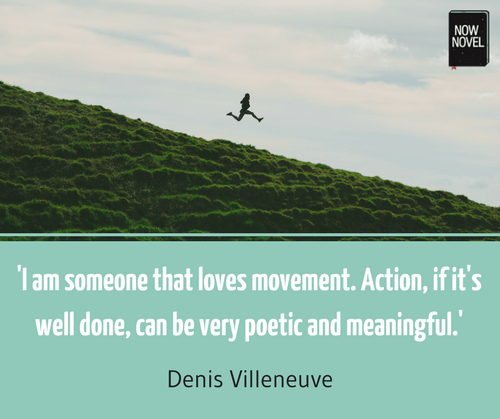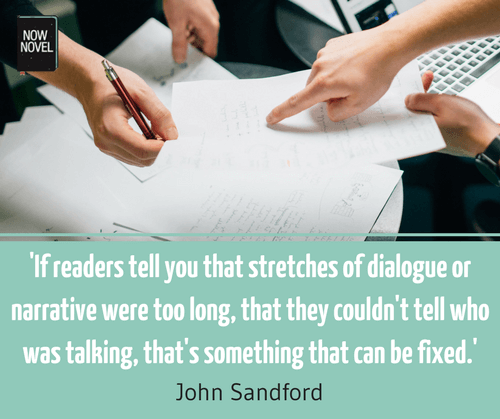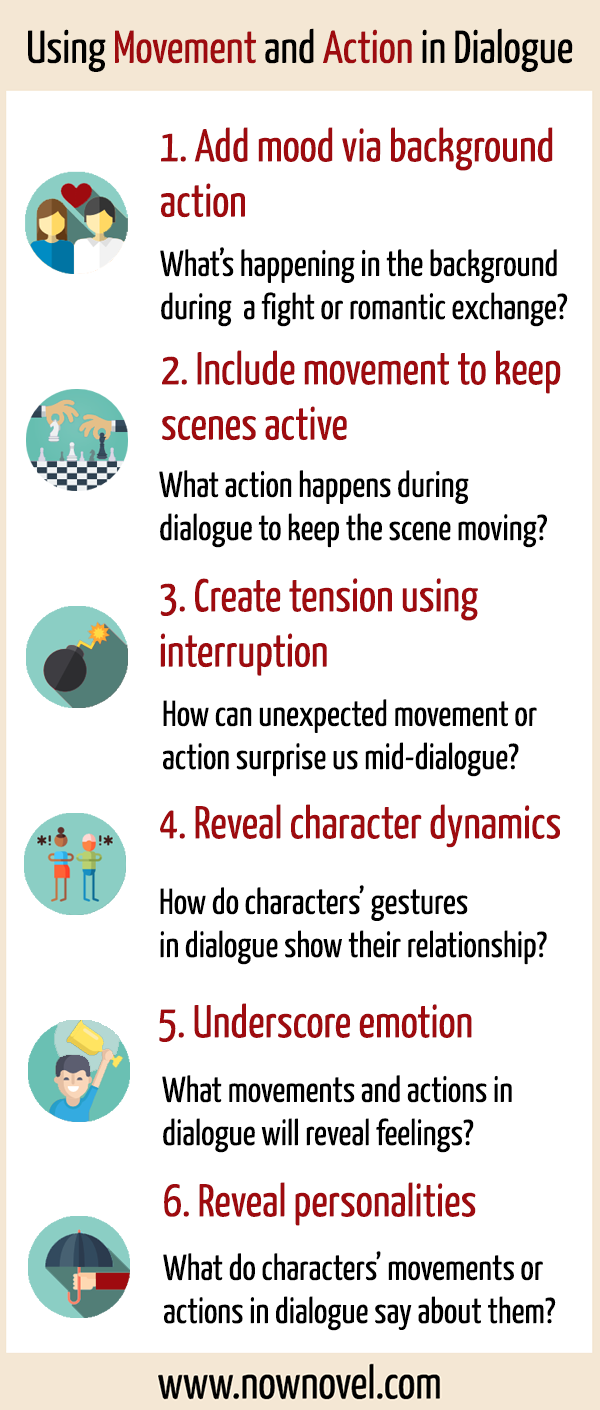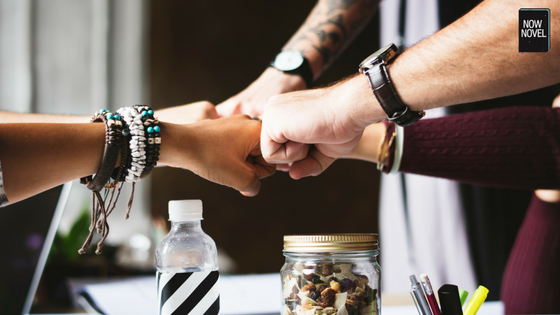Great dialogue in fiction sweeps us up in the story. Movement and action in dialogue are two important elements that serve multiple purposes. Here are tips for writing dialogue that connects your characters to their world:
How to use movement and action in dialogue writing:
- Use background action to add tone and mood
- Add movement in dialogue to keep the story moving
- Use mid-dialogue actions for tense interruption
- Reveal character relationships through gesture
- Add dramatic emphasis to characters’ emotions
- Add gesture and interaction to show personality
Let’s delve into how to write movement and action into your dialogue:
Use background action to add tone and mood
Action or movement in dialogue add important tone and mood. Here’s an example of dialogue-based action and movement that do this subtly:
‘The truth is, for a marriage to survive you don’t need all this talk, talk, talk; all this “I am this” and “I am really like this” like in the papers, all this revelation […]’
Neena frowns, Clara cannot raise serious objection, and the rice is handed around once more.
‘Moreover,’ says Alsana after a pause, folding her dimpled arms underneath her breasts, pleased to be holding forth on a subject close to this formidable bosom, ‘when you are from families such as ours you should have learnt that silence, what is not said, is the very best recipe for family life.’
This example, from Zadie Smith’s White Teeth (2000), shows a conservative British-Indian aunt lecturing her younger nieces.
The actions of this family scene contribute tone. A niece frowns, suggesting disagreement or frustration. The passing around of the rice ‘once more’ suggests a circular discussion, recycled views. There is a sense of repetition (as well as tradition) in the accompanying action. The way the aunt folds her arms suggests a stern, perhaps defensive personality.
Together these extra details convey that while the aunt has many views on marriage, her audience doesn’t necessarily share them. Smith creates this tone before any of the nieces have said a word, effectively, using gesture and action.
Although this is a family scene, with a verbal disagreement, the same principles apply for a tense shootout or scramble against time to diffuse a bomb. In any scene involving dialogue, think of gestures that could show:
- How characters feel about their current situation
- The general mood (is it tense and full of disagreements about to erupt, like the scene above? Harmonious, rather?)
- Characters’ personalities (the aunt comes across as holier-than-thou in the combination of her pleasure lecturing the others and her folded arms)
Add movement in dialogue to keep the story moving
Often we tell stories when we get a chance to gather round, stop, and listen. Like in the family dinner conversation in the example above.
Yet if you have an important conversation between characters in your story, you can bundle dialogue with movement to simultaneously create a smooth transition to new settings or events.
For example, as two horseback riders travel to take news of an impending invasion to a neighbouring kingdom, you might write dialogue that fills in additional exposition. In this case, you have a scene transition that develops your story.
In the following example from Hilary Mantel’s historical novel Wolf Hall (2009), a cardinal and his party are setting off on horseback. Movement and action mid-dialogue add tension and drama to the otherwise static scene:
They are ready to ride. Cavendish looks up. ‘Saints protect us!’ A single horseman is heading downhill at a gallop. ‘An arrest!’
‘By one man?’
‘An outrider,’ says Cavendish, and he says, Putney’s rough but you don’t have to send out scouts.
Here, surrounding movement – the arrival of the not-yet-identified rider – creates a moment of tension and suspense. We wonder who is galloping in and why. The surrounding conversation reveals that the king wishes to arrest one of their company. Thus there is a moment where it seems the rider has come to perform an arrest.
By adding the movement of this hasty arrival, Mantel creates a moment of drama, keeping us focused on unfolding events.

Use mid-dialogue actions for tense interruption
The above example is an effective illustration of using mid-dialogue action to heighten tension in a scene quickly. Actions can support the mood and tone of a scene – for example, affectionate words between lovers – but they’re equally useful for sending the scene veering off into unexpected territory.
Think, for example, of two spies fleeing a heavily guarded military facility. What if a soundproof area with automatic doors suddenly cut off the accomplices completely? Suddenly they can’t communicate and time is running out. An event like this raises the stakes in your scene simply by changing the scenario. The characters move from ‘dialogue is possible’ to ‘dialogue isn’t possible’.
As an exercise, take a scene you’ve written. Think of a an event or third-party action that could interrupt the scene. How might it shift the tone and mood of the scene?
Use scene-structuring devices like this when you want to cut from dialogue to a key event faster [join Now Novel for extra help structuring your book and planning elements of your story].
Reveal character relationships through gesture
Movement and action in dialogue also help reveal how characters feel towards each other.
Imagine this example: A character is friendly with a couple who split up. Believing one former partner to be unavailable for an event she invites the other. Yet both show up, not knowing each other are attending.
How do both characters act and move while everyone around them converses at the party? This example comes from a real experience where one ex kept following the other into whatever room they were in, causing the other to quickly seek a new conversation in another part of the house.
In a scene like this, you could show the character avoiding their ex ducking between different conversations to avoid engaging. If you made each conversation they switch between dramatically different, you could play the scene for comedy. The pointlessness of switching between the conversations could underscore the futility of their attempted avoidance.
In an example like this, you can illustrate how a character feels, without having to tell your reader explicitly that they don’t want to talk to their ex.
Movement and action are useful for showing characters’ blossoming relationships, too. Think of the way, for example, people often mirror each other’s body language – leaning forwards, resting arms on the table – when there is mutual interest.

5. Add dramatic emphasis to characters’ emotions
Movement and actions in dialogue are also helpful for underscoring how characters feel, without letting the dialogue tag do all the work. It’s unnecessary to write, for example:
‘”What the hell does that mean?” He shouted.’
You can also express the intensity of the emotion here through action and movement:
“What the hell does that mean?” Scowling, he pushed his chair back as though he would get up.
The second example conveys a strong sense of both the diner’s irritation and a sense of an abrupt change in the scene. We wonder, ‘what will he do next?’ His next action is foreshadowed.
Using movement and gesture for emphasis is naturally something to use with discretion. Punctuate every line with a dramatic gesture and your book could start to feel like a soap opera or telenovela!
As with all fictional devices used for emphasis (e.g. exclamation marks), the old saying ‘less is more’ often applies.

6. Add gesture and interaction to show personality
Movement, gesture and action in dialogue make important contributions to character development. Does a character touch another’s arm often while they’re talking to them? Are their arms folded? Do they fidget or pay complete, calm attention?
Think of what a character’s movement or gestures during dialogue may reveal. This way you won’t have to spell absolutely everything about characters’ personalities out for readers.
Consider this example:
He waves me forward, motions me back, tells me to keep my head down so the enemy won’t blow it off.
‘You’re dead,’ he says.
‘No I’m not.’
‘Yes you are. They got you. Lie down.’
There is no arguing with him, since he can see the enemy and I can’t. I have to lie down on the swampy ground, propped against a stump to avoid getting too wet, until it’s time for me to be alive again.
In this scene from Margaret Atwood’s novel Cat’s Eye (1989), her narrator, Canadian painter Elaine Risley, remembers a game of pretend with her brother.
The brother’s commanding motions and gestures, coupled with Elaine’s compliance, indicate that he is perhaps the older sibling. They also suggest bossiness (‘there is no arguing with him’ adds to this idea). In total, the memory shows a younger Elaine as compliant, versus the older author who interacts with men from a position of greater personal power. It also conveys family dynamics, an important element of character development in the book.
As the examples above show, there are many ways to use motion, action and gesture to bring your dialogue to life. Use it to convey the tone of a scene – tense or intimate, peaceful or agitated. Use it to heighten suspense or to underscore emotions.
Balancing action and dialogue well creates scenes that your reader can lose themselves in and enjoy without stopping to think ‘I’m reading dialogue right now.’
Want to write better dialogue? Join our four-week dialogue-writing course. Start anytime and get detailed feedback on a final submission applying the dialogue tips and tricks you’ll learn.
Cover source image by rawpixel.com


12 replies on “Writing movement and action in dialogue: 6 tips”
This looks interesting, I’ll be giving it a read.
Thanks, Itameio. Enjoy!
I’m going to make this into a mini editing check-list for my novel. I’d call this gold dust. Thank you!
High praise indeed, Jay. Thank you! Thanks for reading. All the best for your novel.
Your blog is incredible !! Thank you for sharing these advices, i’m definitely going to use them.
Thanks so much, Jubs. I’m glad you’ve found some actionable insights here.
bless you
And you too, Juliana 🙂 thanks for reading our blog.
I’m having a hard time getting comfortable with when to use parenthetical action and when to write it on it’s own line(s).
I think one time parenthetical work is to give the manner in which dialogue should be said.
BOB
(Angrily)
What are you doing?
Im also struggling with montage vs series of shots. Technically a scene can be 1 single shot or several, so the term “series of shots” is kind of misleading because the term is also used to describe a condensed set of takes usually about one theme that convey something above and beyond what a regular scene. My observation in watching movies is that they aren’t always one single theme and nothing I’ve read accounts for this or when it’s okay for it not to be.
I have read articles by professionals who contradict each other as far as what a series of shots means and how it’s used. I’m in the middle of writing a script and feel frustrated by all this.
Also, everything I have read about montages say that they are a series of takes that usually lead to an action scene. Again this has not always been my experience. I have seen them used many times to show passage of time, followed by a subdued scene where people are talking calmly etc.
Hi David, thank you for sharing this. I am more familiar with narrative fiction than scriptwriting to be completely honest with you. The format in the screenplay for Titanic is:
BOB
(Angrily)
What are you doing?
[Character name and direction are center-aligned, then all spoken text left aligned]. Sometimes the spacing between the bracketed direction and speech is single rather double or 1.5 spacing (see the script for The Usual Suspects for example).
Then regarding series of shots vs a montage, the primary difference is that the first is a sequence used to convey chronological events joined together (e.g. a character waking up, brushing their teeth, leaving for work to suggest the mundane daily activities that carry on even in the face of some or other background such as a break-up. A montage, by contrast, is a sequence that may not be in chronological order, a sequence of shots that are edited together to show the passage of time or to convey a mood or emotion. Montages are often used to compress time and show a character’s progress or development over a period of time. For example, a montage might show a character training for a competition or falling in love. The shots in a montage are often connected thematically rather than chronologically.
I hope this is helpful!
I spaced out my dialogue example so it was written the way it would appear in a script and this website pushed it together with everything else I wrote. FRUSTRATING
Hi David, I’m sorry to hear that. Most comments systems don’t have very advanced formatting features. One way to share dialogue the way you want it to appear would be to take a screenshot or screen snip in Word or Docs and share that as an Imgur link.